INSTRUCTIONS
- Answer all the questions in the spaces provided.

Questions
-
- What is meant by each of the following ecological terms:
- Population (1mk)
- community (1mk)
- Ecosystem (1mk)
- Name the equipment used to measure the following factors in an ecosystem:
- light penetration in water. (1mk)
- Wind velocity (1mk)
- Atmospheric pressure (1mk)
- What is meant by each of the following ecological terms:
- Amillipede,grasshopper and crayfish all belong to phylum arthropoda
- State Twomajor characteristics that they have in common. (2mks)
- List two characteristics that are used to sub-divide arthropoda into classes. (2mks)
- Name the spore bearing structure in the members of division pteridophyta. (1mk)
- The diagram below shows a phenomenon which occurs during cell division.
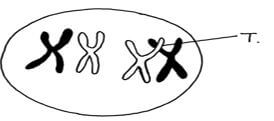
- Name the part labeled T. (1mk)
- State the biological importance of the part labeled T. (1mk)
- Identify the type of cell division in which this phenomenon occurs. (1mk)
- Name the part labeled T. (1mk)
- The diagram below represents a human foetus in a uterus
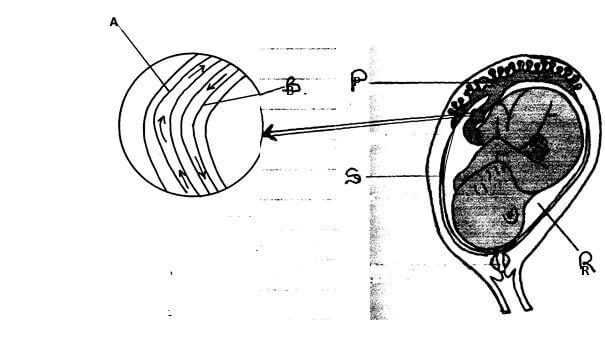
- Name the part labeled S (1mk)
-
- Name the blood vessels labeled A and B (1mk)
A
B - State one difference in composition of blood found in vessels A and B (1mk)
- Name the blood vessels labeled A and B (1mk)
- State the role of the part labeled P (1mk)
- The diagram below represents a fern
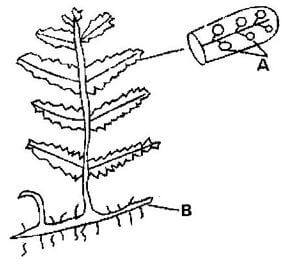
Name- Parts labeled A and B ( 2mks)
A
B - The division which the plant belongs ( 1mk)
An organism with an exoskeleton, segmented body, two pairs of legs per segment, a pair of eyes and a pair of eyes and a pair of short antennae belongs to the phylum (1mk)
- Parts labeled A and B ( 2mks)
- Below is a diagram of an organelle that is involved in aerobic respiration.
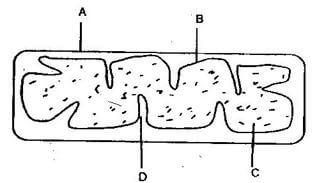
- Name the organelle (1mk)
- Name the parts labeled A, B, and C. (3mks)
A
B
C - What is the purpose of the folding labeled D? (1mk)
- Give the chemical compound which is formed in the organelle and forms the immediate source of energy (1mk)
- The figure represents a feeding relationship in an ecosystem
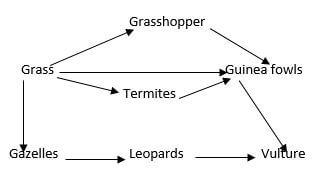
- Write down the food chain in which the Guinea Fowls are secondary consumers (1mk)
- What would be the short term effects on the ecosystem if lions invaded the area (1mk)
- Name the organism through which energy from the sun enters the food web (1mk)
-
- Name the class in the phylum arthropoda which has the largest number of individuals ( 1mk)
- Give two reasons why the organisms named in the class above has the largest population (2mks)
-
- The specific name of Irish potato is solanumTuberrasum
- Identify two errors that have been made when writing the name (2mks)
- What is the species name of Irish potato? (1mk)
- An ecologist came across a plant with the following characteristics, green in colour, non- flowering, compound leaves and sori on the underside of the leaflets. State the probable division of the plan ( 1mk)
- The specific name of Irish potato is solanumTuberrasum
- The number and distribution of stomata on three different leaves are shown in the table below
Leaf
Number of stomata
Upper epidermis
Lower Epidermis
A
B
C
300
150
02
0
200
13
- Suggest the possible habitat of the plants from which the leaves were obtained. ( 3mks)
Leaf Habitat
A ____________________
B ____________________
C ____________________ - State the modification found in the stomata of leaf C (1mk)
- Suggest the possible habitat of the plants from which the leaves were obtained. ( 3mks)
- The following is a simplified drawing of nitrogen cycle.
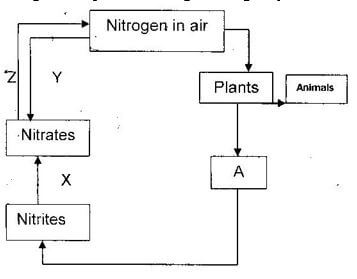
- Identify the compound named A ( ½ mk)
- Name the processes (1 ½ mks)
X _________________
Y _________________
Z _________________
- The diagram below represents a stage during cell division
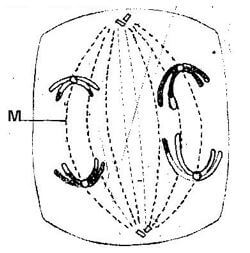
-
- Identify the stage of cell division ( 1mk)
- Give two reasons for your answer (a) (i) above ( 2mks)
- Name the structure labeled M ( 1mk)
-
- Explain 3 ways through which xerophytes are adapted to their habitat. (3mks)

Marking Scheme
-
- What is meant by each of the following ecological terms:
- Population (1mk)
Population- total number of organisms of a given species occupying an area at a certain trophic level
- community (1mk)
It is the total number of plants and animals of different species living together in an area. - Ecosystem (1mk)
- Population (1mk)
- Name the equipment used to measure the following factors in an ecosystem:
- light penetration in water. (1mk)
Seechi disc - Wind velocity (1mk)
Anemometer - Atmospheric pressure (1mk)
Barometer
- light penetration in water. (1mk)
- What is meant by each of the following ecological terms:
- Amillipede,grasshopper and crayfish all belong to phylum arthropoda
- State Twomajor characteristics that they have in common. (2mks)
- Segmented bodies
- Jointed appendages
- Exoskeleton
- Body divided into parts - List two characteristics that are used to sub-divide arthropoda into classes. (2mks)
- Number of body parts
- Number of legs
- Number of wings
- Number of antennae - Name the spore bearing structure in the members of division pteridophyta. (1mk)
Sorus
- State Twomajor characteristics that they have in common. (2mks)
- The diagram below shows a phenomenon which occurs during cell division.

- Name the part labeled T. (1mk)
Chiasmata- State the biological importance of the part labeled T. (1mk)
Site of exchange of genetic materials - Identify the type of cell division in which this phenomenon occurs. (1mk)
Meiosis
- State the biological importance of the part labeled T. (1mk)
- Name the part labeled T. (1mk)
- The diagram below represents a human foetus in a uterus

- Name the part labeled S (1mk)
amniotic membrane/Amnion -
- Name the blood vessels labeled A and B (1mk)
A Umblical vein
B Umblical artery - State one difference in composition of blood found in vessels A and B (1mk)
Umblical vein – rich in nutrients and oxygen.
Umblical artery – rich in CO2 and waste like urea.
- Name the blood vessels labeled A and B (1mk)
- State the role of the part labeled P (1mk)
Cushions foetus against shock
Supports the foetus
Keeps foetus moist (prevent dehydration
- Name the part labeled S (1mk)
- The diagram below represents a fern

Name- Parts labeled A and B ( 2mks)
A Sori
B rhizome - The division which the plant belongs ( 1mk)
Pteridophyta
An organism with an exoskeleton, segmented body, two pairs of legs per segment, a pair of eyes and a pair of eyes and a pair of short antennae belongs to the phylum (1mk) Diplopoda
- Parts labeled A and B ( 2mks)
- Below is a diagram of an organelle that is involved in aerobic respiration.

- Name the organelle (1mk)
Mitochondrion - Name the parts labeled A, B, and C. (3mks)
A Outer membrane
B Inner membrane
C Matrix/Stroma - What is the purpose of the folding labeled D? (1mk)
Increases surface area for attachment of respiratory enzymes - Give the chemical compound which is formed in the organelle and forms the immediate source of energy (1mk)
Adenosinetriphosphate
- Name the organelle (1mk)
- The figure represents a feeding relationship in an ecosystem

- Write down the food chain in which the Guinea Fowls are secondary consumers (1mk)
Grass → Grasshopper → Guinea fowls
Grass → Termites → Guinea fowls - What would be the short term effects on the ecosystem if lions invaded the area (1mk)
Lions would complete with leopards
Gazelle number would reduce
Grass would be increased - Name the organism through which energy from the sun enters the food web (1mk)
Grass
- Write down the food chain in which the Guinea Fowls are secondary consumers (1mk)
-
- Name the class in the phylum arthropoda which has the largest number of individuals ( 1mk)
Insecta - Give two reasons why the organisms named in the class above has the largest population (2mks)
lay many eggs
Inhabit all ecological niches
Wide variety of foods
- Name the class in the phylum arthropoda which has the largest number of individuals ( 1mk)
-
- The specific name of Irish potato is solanumTuberrasum
- Identify two errors that have been made when writing the name (2mks)
Second name should be in small letter.
The names should be underlined separately - What is the species name of Irish potato? (1mk)
tuberrasum - An ecologist came across a plant with the following characteristics, green in colour, non- flowering, compound leaves and sori on the underside of the leaflets. State the probable division of the plan ( 1mk)
Division pteridophyta
- Identify two errors that have been made when writing the name (2mks)
- The specific name of Irish potato is solanumTuberrasum
- The number and distribution of stomata on three different leaves are shown in the table below
Leaf
Number of stomata
Upper epidermis
Lower Epidermis
A
B
C
300
150
02
0
200
13
- Suggest the possible habitat of the plants from which the leaves were obtained. ( 3mks)
Leaf Habitat
A ____________________ Aquatic/Fresh water
B ____________________ Forest
C ____________________ Arid- Semi Arid - State the modification found in the stomata of leaf C (1mk)
- Sunken stomata,
- Reversed rhythm
- Small stomatal pores
- Suggest the possible habitat of the plants from which the leaves were obtained. ( 3mks)
- The following is a simplified drawing of nitrogen cycle.

- Identify the compound named A ( ½ mk)
Ammonia - Name the processes (1 ½ mks)
X _________________ nitrification
Y _________________ nitrogen fixation by ligtning
Z _________________ Denitrification
- Identify the compound named A ( ½ mk)
- The diagram below represents a stage during cell division

-
- Identify the stage of cell division ( 1mk)
Anaphase 1 - Give two reasons for your answer (a) (i) above ( 2mks)
Homologous chromosomes separate at the equator.
Chromosomes start migrating to opposite poles
Sister chromatids attached at the centromere
- Identify the stage of cell division ( 1mk)
- Name the structure labeled M ( 1mk)
Spindle fibres
-
- Explain 3 ways through which xerophytes are adapted to their habitat. (3mks)
Deep rooted to absorbs water from lower water table
Needle like leaves to reduce surface area of water loss
Few stomata to reduce stomatal transpiration
Thick succulent stem,leaves,roots for water storage
Download Biology Questions and Answers - Form 3 Mid Term 2 2022.
Tap Here to Download for 50/-
Get on WhatsApp for 50/-
Why download?
- ✔ To read offline at any time.
- ✔ To Print at your convenience
- ✔ Share Easily with Friends / Students

